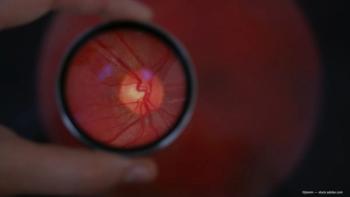
Rates of change may signal primary open-angle glaucoma
Data from the Confocal Scanning Laser Ophthalmoscopy Ancillary Study show that ther eare changes in optic disc topography in eyes with ocular hypertension, whether or not there is progression to primary open-angle glaucoma.
Seven of the 22 OHTS study centers participated in the CSLO Ancillary Study. Patients enrolled at these centers had annual exams using a tomography platform (Heidelberg Retina Tomography-1 [HRT-1], Heidelberg Engineering). The acquired images were processed with software (HRT 3.0 version or higher) at the University of California, San Diego (UCSD) reading center.
Rate of change was analyzed for a number of HRT parameters, including rim area, percent of baseline rim area, rim:disc area ratio, cup volume, retinal nerve fiber layer (RNFL) thickness, RNFL cross-sectional area, and glaucoma probability score (GPS). Change was faster in the rim area parameters, cup volume, and GPS in eyes that developed POAG than in those that did not. There were no significant differences between the two groups of eyes in the rate of change of RNFL parameters.
Measuring change
Analyses presented were based on data from 441 patients (869 eyes) with good-quality CSLO exams. About 17% of the patients were African American. During follow-up, 52 patients (66 eyes) developed POAG based on rigorous OHTS visual field and/or optic disc stereophotographic criteria.
For the eyes with POAG, median follow-up was 5.6 years to the time they reached the diagnostic endpoint (maximum 12 years) while the median available follow-up for the eyes that did not develop POAG was 11 years (maximum, 14 years). Of the patients who had progression to glaucoma, about two-thirds were diagnosed on the basis of reaching an optic disc deterioration endpoint only. During ongoing follow-up, about one-fourth of patients developed both optic disc deterioration and visual field abnormalities.
The analyses of rate of topographic optic disc changes were performed using multivariable mixed effects models to compare the slopes of changes in individual HRT parameters over time in eyes that did and did not develop POAG. The covariates included in the model were race, randomization to treatment, and baseline age, central corneal thickness, stereophotograph-based horizontal cup:disc ratio, IOP, visual field pattern standard deviation, and disc area.
Newsletter
Don’t miss out—get Ophthalmology Times updates on the latest clinical advancements and expert interviews, straight to your inbox.








































